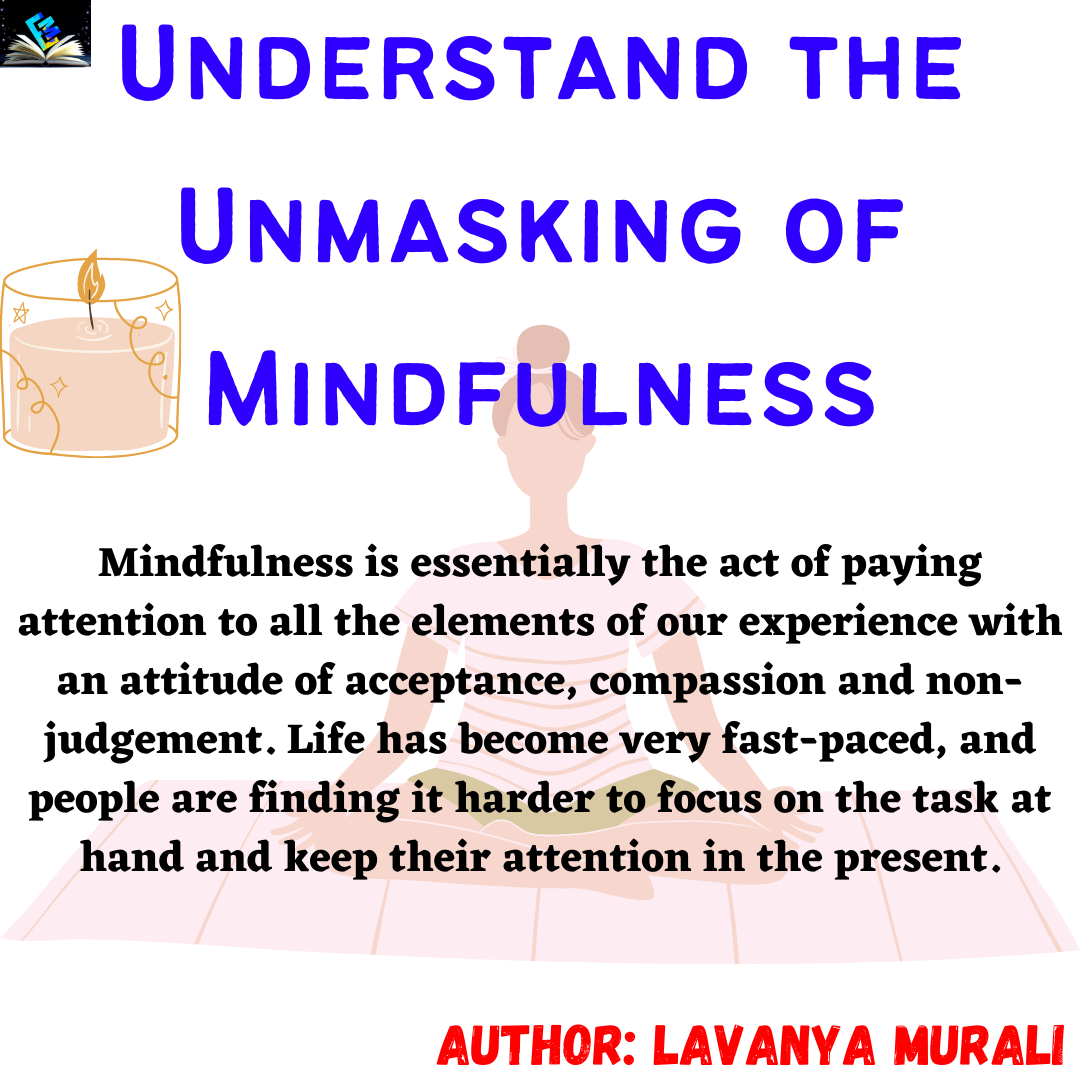
Understand the Unmasking of Mindfulness
Mindfulness is essentially the act of paying attention to all the elements of our experience with an attitude of acceptance, compassion and non-judgement. Life has become very fast-paced. People are finding it harder to focus on the task at hand and keep their attention in the present.
Author: Lavanya Murali
In recent years, mindfulness has been a trending topic. The concept, however, can seem mystic and inscrutable to people. This article explores the basics of mindfulness, to demystify and clarify the concept.
Introduction to Mindfulness
Mindfulness is essentially the act of paying attention to all the elements of our experience with an attitude of acceptance, compassion and non-judgment. Life has become very fast-paced. People are finding it harder to focus on the task at hand and keep their attention in the present.
As said by Gilbert and Killingsworth (2010), “People spend about 47% of their waking hours thinking about something other than what they are doing”. It is becoming increasingly difficult to remain in the present, and not think about the presentation next week or the mistakes made in the last meeting. Slowly we have all begun to ignore the present and excessively either mull over the past or envision the future. Research has proved that people are less happy when their minds are wandering, even if the content of their thoughts is pleasant. This is because when we are not focusing, we are vulnerable and we can easily miss out on the things life has to offer.
Mindfulness involves the deliberate and conscious direction of our attention. It teaches us how to be disciplined with our focus and remain in the present. When this happens, we will be able to receive all that life has to offer. Mindfulness and mindfulness-based meditation has been proved to have an impact on an individual’s ability to manage stress.
Mindfulness is not just about bringing attention to the here and now. It is about accepting these experiences with openness and curiosity. It is also allowing us to become detached observers of our senses, perceptions, thoughts, and emotions. Practicing mindfulness is a lifestyle to expand our capacity and pay attention for a long time, importantly when attention wanders. It is through this observation and detection that we can consciously choose to become more aware and shift our focus. Over time, this refocusing helps us rise out from a place of acting by unconscious habit.
Viewer Perspective
From an observer’s standpoint, we can objectively interrogate our own experiences and understand the situation as a whole, with lowered emotional reactivity to our shortcomings. This leads us to evaluate ourselves in an unbiased manner without gravely damaging our self-esteem and self-concept. It is useful for understanding ourselves better and aids us in taking things at face value or without overestimating their importance.
This leads to better decision-making, better goal achievement and reduced interpersonal and intrapersonal problems.
As a result, we gain an understanding of the events, thoughts, behaviors and emotions that push us to react, and this is one of the most important steps in shedding the shackles of habitual behaviours and mental spirals that have been problematic to our wellbeing.
This brings stability into life, in terms of emotions, moods, perceptions and various other aspects. People who practise mindfulness have reported having better control over their moods and behaviours. They also reported less cognitive and physiological arousal before sleeping. This suggests that increased emotional stability during the day can even translate into a more restful sleep.
In a study done by Hölzel et al., the structure of the brain changes when mindfulness meditation is practiced. In post-experiment MRIs, an increase in grey-matter density in the hippocampus, which is important for learning and memory was found. This increase was also observed in structures associated with self-awareness, compassion and introspection.
Grey matter density was observed to be decreased in the amygdala, a brain area known to play a vital role in anxiety and stress. Reduction of the grey matter density can be related to the participant reduced stress level.
There is a clear, marked increase in the number of mindfulness-based psychotherapies.
A group from Melbourne, the Melbourne Academic Mindfulness Interest Group has concluded that “the combination of some well-developed conceptual models for the therapeutic action of mindfulness and a developing empirical base, justifies a degree of optimism that mindfulness-based approaches will become helpful strategies to offer in the care of patients with a wide range of mental and physical health problems”.(Academic Mindfulness Interest Group & Academic Mindfulness Interest Group, 2006).
Mindfulness is also a popular treatment for reducing anxiety. In 2017, an NIH-sponsored clinical trial led by a Georgetown University Medical Center researcher has found physiological evidence that mindfulness meditation combats anxiety. Another research has proved that mindfulness-based stress reduction (MBSR) is effective in reducing blood pressure in people with pre-hypertension or borderline high blood pressure.
Mindfulness Practice
Formed through a collaboration between UC Berkeley’s Greater Good Science Centre and HopeLab.
The Organisation Greater Good in Action has enumerated certain habits that are helpful in beginning one’s mindfulness practice:
- Paying close attention to your breathing, especially while experiencing intense emotional responses.
- Carefully observe and attend to the things you are sensing in a given moment – what you can see, smell, hear, that could go unnoticed without careful attention.
- Understand that thoughts and emotions are fleeting and do not define yourself by these. This practice can free you from negative thought patterns.
- Finally, regard with close attention the senses in your body at any point, whether it be while sitting in a chair or cooking in the kitchen.
Conclusion
Mindfulness is a practice that involves reverting out attention and sustaining in the present to increase our quality of life. With the dynamics of the world today, this is a much-needed habit that we must incorporate into our lifestyle.
Living in present can truly be a gift if we choose to accept it. Staying attuned to the events occurring here and now can offer critical insights into ourselves and our dispositions. The information we receive from the environment and ourselves once accepted without judgment and bias with compassion and understanding. This can benefit us greatly in terms of setting and achieving goals, managing emotions and behaviors. It can also help us in governing our relationships with others and ourselves.
Mail us at info@edumound.com






